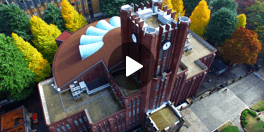December 2, 2022
Steven Feiner教授のVR・AR特別講義Prof. Steven Feiner's Lecture on Virtual Reality and Augmented Reality
東京大学ヒューマンオーグメンテーション社会連携講座、および総合分析情報学特論XIIの特別講義として、バーチャルリアリティ、オーグメンティッドリアリティの世界的権威であるコロンビア大学のSteven Feiner教授をお招きして以下の講演会を開催します。ふるってのご参加をお願いいたします。
As a special lecture of the University of Tokyo’s Human Augmentation Research Initiative and Advanced Lectures in Applied Computer Science XII, Professor Steven Feiner of Columbia University, a world authority on virtual reality and augmented reality, will give the following lecture. We look forward to your participation.
開催概要
日時: 2022年12月2日(金) 10:00-
場所: ダイワユビキタス学術研究館3Fシアター
Date & Time: Dec.2, 2022 (Fri) 10:00-
Lecture room: Daiwa Ubiquitous Computing Research Building 3F Theater
Title: Cueing Action in Augmented Reality and Virtual Reality
Speaker:
Steven Feiner, Professor, Department of Computer Science
Columbia University
http://www.cs.columbia.edu/~feiner/
Abstract:
For over fifty years, researchers have been investigating how augmented reality (AR) and virtual reality (VR) can help people perform tasks, training them in advance or assisting them on the fly. In these tasks, users are typically given information about the current step (cues), either immediately before or while doing it. However, many tasks, in the real world and in AR and VR, also use precues about what to do after the current step. We have been exploring how precueing multiple steps in AR and VR can influence performance, for better or for worse, in ordered sequential tasks ranging from simple path following to translating and rotating physical objects, and in unordered bimanual tasks with potentially concurrent actions. I will present some of our results on the effectiveness of different numbers and types of cues and precues and the visualizations through which they are communicated.
Professor Steve Feiner’s Bio:
Steve Feiner is a Professor of Computer Science at Columbia University, where he directs the Computer Graphics and User Interfaces Lab. His lab has been conducting AR and VR research for over 25 years, designing and evaluating novel 3D interaction and visualization techniques, creating the first outdoor mobile AR system using a see-through head-worn display and GPS, and pioneering experimental applications of AR and VR to a wide range of fields. Steve is a Fellow of the ACM and the IEEE and a member of the CHI Academy and the IEEE VR Academy. He is the recipient of the ACM SIGCHI Lifetime Research Award, the IEEE ISMAR Career Impact Award, and the IEEE VGTC Virtual Reality Career Award. Together with his students and colleagues, he has won the IEEE ISMAR Impact Paper Award, the ISWC Early Innovator Award, and the ACM UIST Lasting Impact Award. Steve has served as general chair or program chair for over a dozen ACM and IEEE conferences and is coauthor of two editions of Computer Graphics: Principles and Practice.

